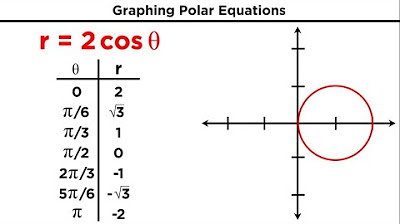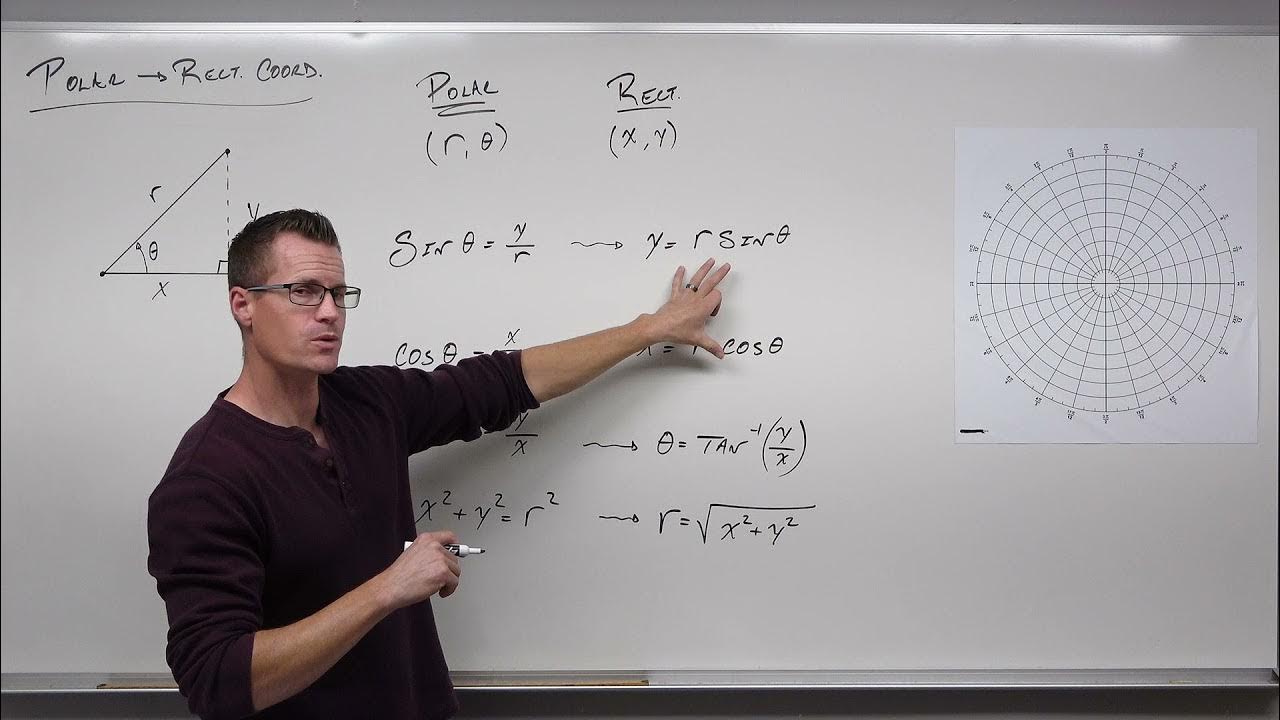Ch. 8.1 Polar Coordinates
TLDRThis educational video script introduces Chapter 8 on polar coordinates, offering a fresh perspective on plotting points beyond the Cartesian coordinate system. It explains the concept of polar coordinates using radius and angle instead of x and y, and establishes the trigonometric relationships between the two systems. The script also discusses the non-uniqueness of polar coordinates and provides examples of converting between polar and rectangular forms, including transforming equations like y = x^2 into polar form and vice versa.
Takeaways
- 📚 The script introduces Chapter 8 focusing on polar coordinates, an alternative system to the rectangular (Cartesian) coordinate system.
- 📐 Polar coordinates utilize a radius and an angle (r and θ) instead of x and y to define a point's location on a graph.
- 🔍 The transition from rectangular to polar coordinates involves calculating the radius as the distance from the origin (√(x² + y²)) and the angle using the arctangent of y/x.
- 🔄 The reverse conversion from polar to rectangular coordinates is done by substituting x with r*cos(θ) and y with r*sin(θ).
- 🌐 Polar coordinates are not unique; a single point can be represented by infinite combinations of radius and angle, accounting for different quadrants and angles.
- 🤔 The script explains that polar coordinates are particularly relevant for equations involving circles and angles, which are common in trigonometry.
- 📉 The example given demonstrates converting a point from polar to rectangular coordinates, showing how to apply trigonometric relationships.
- 📈 The script also covers converting equations, such as y = x², into polar form by substituting x and y with their polar equivalents.
- 🔄 An example of converting a polar equation to a rectangular form is provided, illustrating the process and potential complexities involved.
- 🔍 The importance of understanding trigonometric relationships for conversions between coordinate systems is emphasized throughout the script.
- 📝 The script concludes by noting that polar equations often result in implicit forms rather than explicit y = f(x) forms, which is a characteristic of polar coordinate representation.
Q & A
What is the main topic of Chapter 8?
-The main topic of Chapter 8 is polar coordinates, which is an alternative way to represent points on a graph compared to the rectangular (Cartesian) coordinate system.
What are the other coordinate systems mentioned in the script besides polar coordinates?
-Besides polar coordinates, the script mentions cylindrical coordinates, spherical coordinates, parametric equations, and vector equations as other ways of representing points in space.
How does the rectangular coordinate system differ from the polar coordinate system?
-The rectangular coordinate system uses x and y to plot points on a graph, moving horizontally and vertically from the origin. In contrast, the polar coordinate system uses a radius and an angle to determine a point's location, starting from the origin and moving outwards and then rotating an angle.
What is the mathematical relationship between the rectangular and polar coordinates?
-The radius (r) in polar coordinates is the distance from the point to the origin, calculated as the square root of x squared plus y squared. The angle (theta) is found using the inverse tangent of y over x. To convert from polar to rectangular, x is r cosine theta, and y is r sine theta.
Why are polar coordinates not unique?
-Polar coordinates are not unique because a single point can be represented by infinitely many combinations of radius and angle. This is due to the periodic nature of the trigonometric functions used to define the angle.
How can you represent the same point in polar coordinates in multiple ways?
-You can represent the same point in polar coordinates by using different angles that are coterminal (angles that differ by a multiple of 2π) and by using positive or negative values for the radius, adjusting the angle accordingly.
What is the process of converting a polar equation to a rectangular equation?
-To convert a polar equation to a rectangular equation, you substitute r cosine theta for x and r sine theta for y in the polar equation, and then simplify the resulting expression.
Can every polar equation be converted into a form where y equals a specific expression?
-No, not every polar equation can be converted into a form where y equals a specific expression. Many polar equations result in implicit forms that involve both x and y.
How is the conversion of a rectangular equation to a polar equation demonstrated in the script?
-The script demonstrates the conversion by taking the rectangular equation y = x squared and substituting x with r cosine theta and y with r sine theta, then isolating r to form the polar equation r = cosine squared theta over sine squared theta.
What is an implicit equation and why is it common in polar coordinates?
-An implicit equation is one where the variables are not explicitly isolated on one side of the equation. It is common in polar coordinates because of the nature of the relationships between x and y involving trigonometric functions, often resulting in equations that cannot be simplified to y equals a specific expression.
Outlines
📚 Introduction to Polar Coordinates
The instructor begins by introducing Chapter 8, which focuses on polar coordinates. They explain that polar coordinates offer an alternative method to represent points on a graph, as opposed to the traditional rectangular (Cartesian) coordinate system. The Cartesian system uses x and y values, while polar coordinates utilize a radius and an angle (r and θ). The instructor illustrates the concept by comparing the movement in both systems, emphasizing that polar coordinates are not unique and can have multiple representations for the same point. They also mention other coordinate systems like cylindrical and spherical for three dimensions, and parametric equations and vector equations as alternative representations.
🔍 Conversion Between Rectangular and Polar Coordinates
This paragraph delves into the mathematical relationship between rectangular and polar coordinates. The instructor explains how to convert from x and y to r and θ, using the formulas for radius (r = √(x² + y²)) and angle (θ = tan⁻¹(y/x)). They also discuss the reverse conversion, from polar to rectangular coordinates, using x = r*cos(θ) and y = r*sin(θ). The importance of understanding these relationships is highlighted for solving problems that involve both coordinate systems.
🌐 Non-Uniqueness of Polar Coordinates
The instructor addresses the non-uniqueness of polar coordinates, demonstrating that a single point can be represented in multiple ways using different angles and the same radius. They provide an example using the point (3, -3√3) and show how it can be represented in four different ways in polar coordinates, including adjusting for the correct quadrant and using both positive and negative values for the radius. The concept is further explained with the idea that there are infinite ways to represent a single point in polar coordinates.
📉 Examples of Converting Polar to Rectangular Coordinates
The instructor provides an example of converting a given set of polar coordinates (r, θ) into rectangular coordinates. Using the polar coordinates (2, 7π/6), they apply the formulas x = r*cos(θ) and y = r*sin(θ) to find the equivalent x and y values, resulting in the rectangular coordinates (-√3, -1). This practical example illustrates the process of converting between coordinate systems.
📐 Converting Polar Equations to Rectangular Form
The final paragraph discusses the process of converting polar equations into their rectangular equivalents. The instructor uses the example of the equation r = 2/(1 - 2*cos(θ)) and demonstrates the substitution process, replacing r*cos(θ) with x and r*sin(θ) with y. They explain that the resulting equation may not always be in the form y = something, but rather a more complex relationship involving both x and y. The instructor emphasizes that this complexity is inherent to polar coordinates and that it is acceptable to have an equation that does not simplify to a single variable.
Mindmap
Keywords
💡Polar Coordinates
💡Rectangular Coordinate System
💡Radius
💡Angle (Theta)
💡Cylindrical Coordinates
💡Spherical Coordinates
💡Parametric Equations
💡Vector Equations
💡Conversion between Polar and Rectangular Coordinates
💡Non-uniqueness of Polar Coordinates
💡Polar Equations
Highlights
Introduction to Chapter 8 on polar coordinates as an alternative to the rectangular coordinate system.
Explanation of the rectangular coordinate system, also known as the Cartesian coordinate system, as the standard for plotting points and functions.
Introduction of other coordinate systems such as cylindrical, spherical, parametric equations, and vector equations for three dimensions.
Transition to polar coordinates using radius and angle instead of x and y to plot points.
Description of the process to plot a point in polar coordinates by moving over a radius and sweeping an angle.
The order of radius first, then angle, in polar coordinates and their significance in reaching a point.
The relationship between rectangular (x, y) and polar (r, θ) coordinates and the formulas to convert between them.
The method to find the radius using the distance formula derived from the Pythagorean theorem.
Determination of the angle in polar coordinates using the arctan function of y/x.
Conversion formulas from polar to rectangular coordinates: x = r cos(θ) and y = r sin(θ).
Non-uniqueness of polar coordinates and the infinite ways to represent the same point in polar form.
Example of representing the point (3, -3√3) in four different polar coordinate forms.
Demonstration of converting polar coordinates to rectangular coordinates using the given formulas.
The process of converting a rectangular equation to a polar equation by substituting x with r cos(θ) and y with r sin(θ).
Example of converting the equation y = x^2 into a polar equation by using trigonometric substitutions.
Explanation of the challenges in converting polar equations to rectangular form and the implicit nature of such equations.
Conversion of the polar equation r = 2 / (1 - 2 cos(θ)) to its equivalent rectangular form.
Emphasis on the importance of understanding trigonometric relationships for coordinate conversions.
Transcripts
Browse More Related Video

Precalculus: Polar Coordinates (Section 9.1) | Math with Professor V

Polar coordinates 2 | Parametric equations and polar coordinates | Precalculus | Khan Academy

Polar Coordinates and Graphing Polar Equations

How to Convert From Polar Coordinates to Rectangular Coordinates (Precalculus - Trigonometry 37)

Calculus 2: Polar Coordinates (Video #30) | Math with Professor V

Polar coordinates 3 | Parametric equations and polar coordinates | Precalculus | Khan Academy
5.0 / 5 (0 votes)
Thanks for rating: